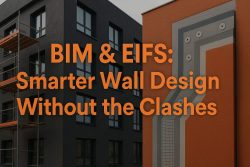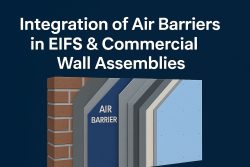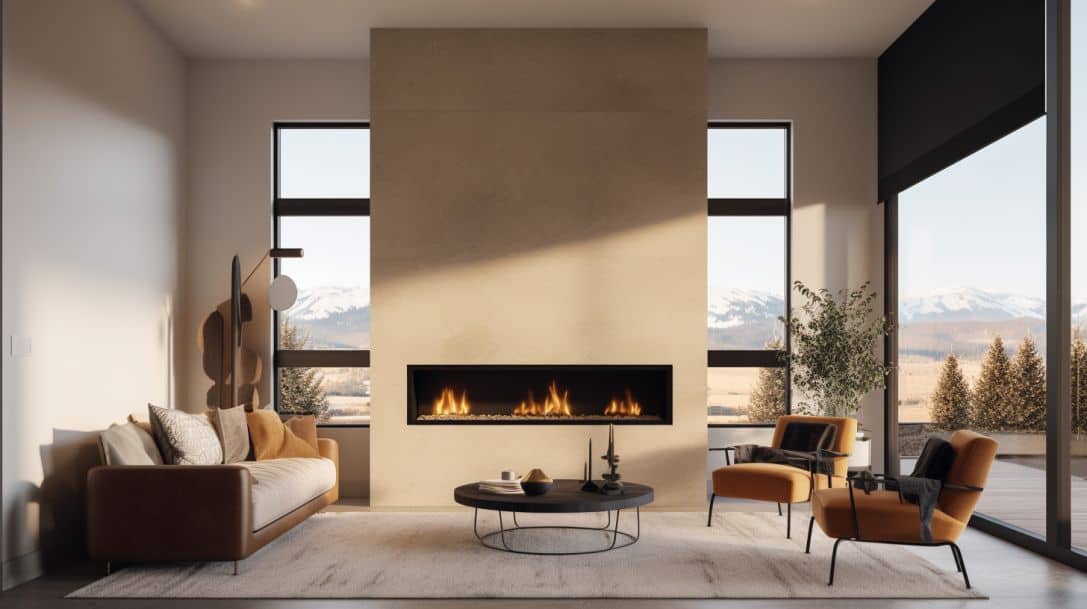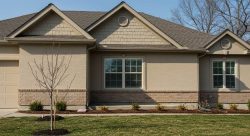Transform Your EIFS Designs: Discover How Natural Elements Enhance Aesthetics, Sustainability, and Energy Efficiency
Many builders struggle to mix nature with modern building designs. EIFS, or Exterior Insulation and Finish Systems, offers a way to do this. This blog will show you how to add natural touches to EIFS designs.
Get ready to learn about eco-friendly buildings!
Key Takeaways
- EIFS with natural elements can cut energy use by 10-30% in buildings.
- Adding plants, stone, and wood to EIFS makes buildings look better and more eco-friendly.
- EIFS lasts over 50 years with proper care and helps buildings earn LEED credits.
- New tech like smart sensors and self-healing materials are making EIFS even better.
- EIFS inspections check for proper moisture barriers, drainage, and insulation to ensure safety.
Understanding EIFS in Modern Architecture

EIFS stands for Exterior Insulation and Finish Systems. It’s a popular choice in modern buildings for its energy-saving and design perks. EIFS offers a mix of insulation and good looks, making it a smart pick for today’s architects.
Definition and Features of EIFS
EIFS stands for Exterior Insulation and Finish Systems. It’s a type of wall cladding that looks like stucco but offers better insulation. EIFS has several layers: an insulation board, a base coat with mesh, and a finish coat.
This system keeps buildings warm in winter and cool in summer.
EIFS boasts many great features. It’s lightweight, energy-efficient, and lasts over 50 years with proper care. The outer layer can mimic various textures like brick or stone. EIFS also resists cracks and weather damage better than traditional stucco.
Its high R-value, about R-5 to R-7 per inch, makes it a top choice for green building designs.
Role of EIFS in Sustainable Design
EIFS plays a key role in sustainable design. It helps buildings use less energy, which is good for the planet. In fact, buildings with EIFS can use 10-30% less energy than regular ones.
This means lower bills and less harm to nature.
EIFS also helps with LEED ratings. LEED is a system that rates how green a building is. EIFS can help in many areas of LEED. These include energy use, reusing old buildings, and waste management.
It also helps with indoor air quality. All these make EIFS a smart choice for eco-friendly design.
EIFS is not just a wall system; it’s a sustainable solution for modern architecture.
The Importance of Natural Elements in EIFS Designs

Natural elements bring life to EIFS designs. They make buildings more appealing and eco-friendly.
Enhancing Aesthetic Appeal
EIFS designs can look amazing with natural touches. Architects mix in things like stone, wood, and plants to make buildings pop. This blend of EIFS and nature create unique looks that catch the eye.
It also helps buildings fit better with their surroundings.
Adding natural elements to EIFS does more than just look good. It can boost a building’s green features too. For example, using local materials cuts down on transport costs. Living walls made with EIFS can clean the air and cool the building.
These smart design choices make EIFS buildings both pretty and eco-friendly.
Contributing to Sustainability
EIFS designs help buildings use less energy. They add a layer of insulation that keeps heat in during winter and out in summer. This cuts down on heating and cooling costs. For example, the Ark Encounter in Kentucky used R-11 EPS insulation.
It lowered CO2 emissions by over 3,000 tons each year.
Natural elements in EIFS make buildings even greener. They can include recycled materials or plant-based products. These choices reduce waste and save resources. Some EIFS designs also use living plants on walls.
This helps clean the air and cool the building naturally.
Innovations Integrating Natural Elements with EIFS
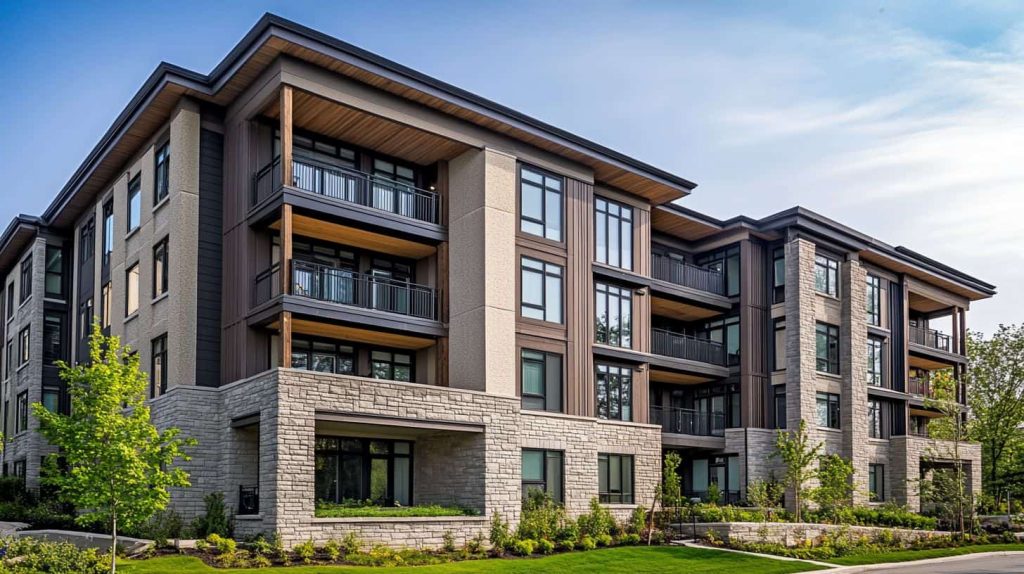
EIFS designs now blend nature with modern tech. Builders mix natural rocks into EIFS and add living plants to walls.
Use of Natural Aggregates in EIFS
Natural aggregates boost EIFS in many ways. They make the insulation better and help buildings last longer. These tiny bits of nature also make EIFS look nicer. Builders mix things like sand or small stones into the outer layer of EIFS.
This mix helps cut down on energy use. It keeps buildings cooler in summer and warmer in winter. As a result, people use less power for heating and cooling.
Smart tech and natural aggregates work well together in EIFS. This team-up makes buildings more comfy and cheaper to take care of. For example, sensors can track how the building is doing.
They can tell if the EIFS needs fixing before big problems happen. This smart approach saves money and keeps the building in top shape. It’s a win for both owners and the earth.
Incorporation of Living Plants
Living plants bring life to EIFS designs. Builders add green walls or hanging gardens to building exteriors. These plants make buildings look better and help the environment. They clean the air, cool the area, and give homes to small animals.
Some EIFS systems now have special spots for plants to grow. This mix of plants and walls creates a unique look that many people love.
Designers use many types of plants in EIFS. Vines can climb up walls. Small bushes fit in pockets on the surface. Even moss and grass can grow on some EIFS designs. These plants need care, but they offer big rewards.
They save energy, cut noise, and make people feel good. Plus, they help buildings blend in with nature. This green touch makes EIFS stand out from other building methods.
Natural Color Pigments and Textures
Natural color pigments bring life to EIFS designs. These pigments come from earth, plants, and minerals. They create rich, deep hues that blend with nature. Designers mix these pigments into EIFS to make buildings look more organic.
Textures add depth to EIFS surfaces. Rough, smooth, or patterned finishes mimic natural materials like stone or wood. These textures catch light in unique ways, changing how a building looks throughout the day.
By using both natural colors and textures, EIFS can make buildings more visually appealing and connected to their surroundings.
Benefits of Integrating Natural Elements into EIFS
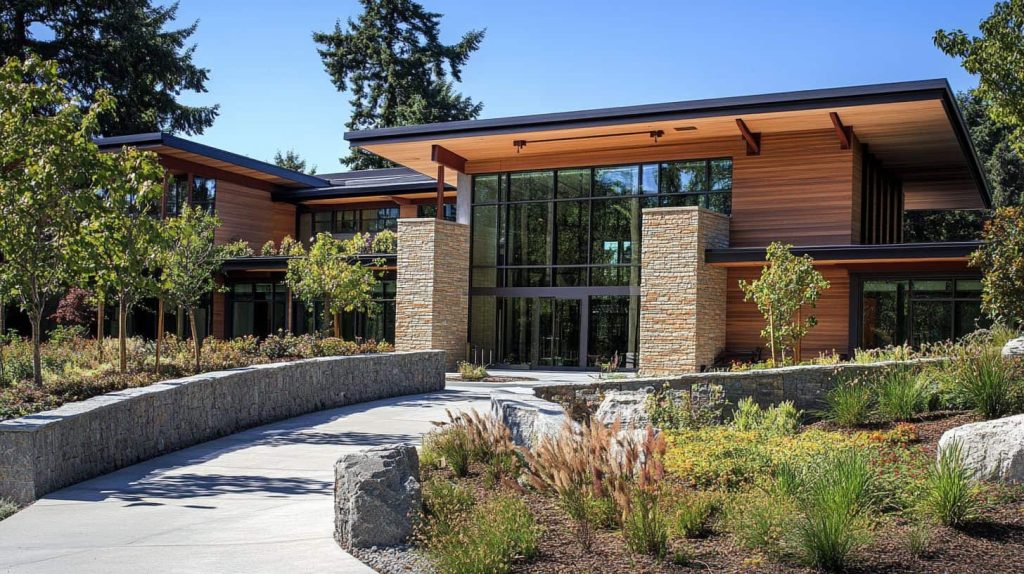
Natural elements in EIFS designs boost energy savings and extend building life. They also help earn LEED credits, making structures more eco-friendly.
Improved Energy Efficiency
EIFS helps buildings save energy. It acts like a warm coat, keeping heat inside during winter and outside in summer. This cuts down on heating and cooling costs. For example, the Grand Concourse Academy in the Bronx added R-16 insulation with EIFS.
They got money back from New York State for being energy-smart.
Buildings with EIFS use 10-30% less energy than regular ones. That’s a big deal for saving money and helping the planet. EIFS wraps around a building, sealing air leaks and stopping heat from escaping.
This makes rooms comfy without working the heater or AC too hard.
Enhanced Building Longevity
EIFS designs with natural elements boost building life. These systems protect walls from harsh weather and temperature changes. They also stop moisture damage, which can rot wood and rust metal.
Natural elements like stone or plant-based materials add extra strength. This mix of EIFS and nature creates a tough shield that lasts for decades.
Proper care makes EIFS buildings last over 50 years. Regular checks and fixes keep the system strong. Natural elements need less upkeep than man-made parts. This saves money and time for owners.
The long life of EIFS with natural elements makes buildings more valuable over time.
LEED Rating System Credit Contributions
EIFS helps buildings get LEED credits. These credits show a building is eco-friendly. EIFS boosts energy use, saves materials, and makes indoor spaces better. It also helps reuse old buildings and cut down on waste.
This makes EIFS a top choice for green building projects.
LEED looks at many parts of a building. EIFS scores well in key areas like energy, materials, and indoor quality. It keeps heat in or out, saving power. EIFS uses less stuff to make and lasts longer.
Plus, it doesn’t give off bad fumes inside. All these good points add up to more LEED credits.
Everything to Know About EIFS in Construction
EIFS stands for Exterior Insulation and Finish System. It’s a popular choice for building exteriors. This system has many parts. It includes insulation boards, a base coat, mesh, and a finish coat.
EIFS offers great insulation, with R-values of R-5 to R-7 per inch. This means it keeps buildings warm in winter and cool in summer.
Builders love EIFS for its energy savings. It stops air from getting in or out of buildings. This cuts down on heating and cooling costs. EIFS also looks good. It can mimic stone, brick, or stucco.
Plus, it’s light and easy to install. These features make EIFS a smart pick for modern construction projects.
Preserving History: Integrating EIFS with Heritage Architecture
EIFS plays a key role in keeping old buildings alive. It helps save their looks while making them work better. Smart materials like aerogel fit right in with EIFS. They give great insulation without changing how the building looks.
This mix of old and new keeps the building’s charm while making it more comfy inside.
New tech makes EIFS even better for old buildings. 3D printing can make custom EIFS parts that match old styles. IoT tools can check how well EIFS works all the time. These tricks help save energy and keep people cozy.
They do all this while keeping the building’s old-time feel. Indiana Wall Systems uses these smart ideas to blend new tech with old beauty.
Maximizing ROI: Financial Benefits of EIFS vs. Traditional Cladding
EIFS offers significant financial advantages over traditional cladding systems. Let’s explore the key benefits that make EIFS a smart investment for building owners and developers.
| Benefit | Description |
| Energy Savings | EIFS can reduce energy costs by up to 30%. The Ark Encounter in Kentucky saved $250,000 annually with R-11 EPS insulation. |
| Lower Installation Costs | EIFS installation is often faster and requires less labor than brick or stone, cutting project timelines and expenses. |
| Reduced Maintenance | EIFS needs less upkeep than wood or metal siding, saving money on long-term maintenance. |
| Durability | EIFS lasts longer than many traditional claddings, delaying replacement costs. The White Castle in Orlando withstood Hurricane Irma, proving its strength. |
| Tax Incentives | Energy-efficient EIFS can qualify for tax credits, as seen with the White Castle project in Florida. |
| Design Flexibility | EIFS allows for custom shapes and finishes without the high cost of specialized materials. |
| Lightweight Construction | EIFS reduces structural requirements, potentially lowering foundation and support costs. |
These benefits combine to create a strong ROI for EIFS projects. Building owners can expect lower upfront costs, reduced operating expenses, and increased property value over time.
Most Overlooked Benefits of EIFS Installation
EIFS offers more than meets the eye. Many people miss its hidden perks. For one, it acts like a sound barrier. This means less noise from outside gets in. It also helps keep indoor sounds from escaping.
This is great for privacy and peace.
Another often-missed benefit is its ability to resist mold and mildew. EIFS doesn’t hold water, so these pesky growths can’t take hold. This makes it a smart choice for damp areas.
Plus, it’s easy to clean and maintain. These features save time and money in the long run. With over 25 years of experience, Indiana Wall Systems knows these benefits well.
EIFS Inspections: What Inspectors Look For
EIFS inspections play a key role in building safety. Inspectors check specific areas to ensure proper installation and performance.
- Moisture barriers: Inspectors look for the correct placement and sealing of moisture barriers. These barriers stop water from getting behind the EIFS.
- Flashings: Proper flashing around windows, doors, and other openings is crucial. Inspectors check for correct installation to prevent water entry.
- Sealants: All joints and seams must have the right sealant. Inspectors make sure these are in place and working well.
- Drainage systems: EIFS needs good drainage to work right. Inspectors check for proper channels that let water out.
- Insulation board: The foam board must be of the right thickness and type. Inspectors look for gaps or damage in the insulation.
- Base coat: A smooth, even base coat is important. Inspectors check for the right thickness and coverage.
- Mesh reinforcement: The mesh must be fully covered by the base coat. Inspectors look for any exposed areas.
- Finish coat: The top layer should be even and free of cracks. Inspectors check for color match and texture.
- Expansion joints: These allow for building movement. Inspectors ensure they are in the right places and working well.
- Impact resistance: The EIFS should stand up to normal wear. Inspectors may test its strength in key areas.
The Untold Truth about EIFS Energy Efficiency
EIFS systems pack a powerful punch in energy savings. They can cut energy use by 10-30% compared to standard building methods. This big drop comes from EIFS’s top-notch insulation.
Each inch of EIFS gives an R-value of 5 to 7. That’s a lot of heat kept in during winter and out during summer. The result? Lower bills and a smaller carbon footprint.
But there’s more to the story than just numbers. EIFS wraps buildings in a smooth, unbroken layer of insulation. This stops heat from escaping through weak spots like studs or joints.
It’s like giving your home a cozy blanket that fits perfectly. Plus, EIFS helps control moisture, which further boosts its energy-saving power. With proper care, these benefits last for decades, making EIFS a smart long-term choice for eco-friendly buildings.
Challenges and Considerations
EIFS designs with natural elements face unique hurdles. These include keeping the structure strong, caring for living parts, and adapting to weather changes. Want to learn more about these challenges? Keep reading!
Ensuring Structural Integrity
Structural integrity is key for EIFS designs with natural elements. Builders must check that the base layer can hold the extra weight. They need to use strong fasteners and adhesives to keep everything in place.
Regular checks help spot any weak spots early on.
Proper installation is vital to avoid moisture issues. Experts seal all joints and edges carefully. They also add drainage systems to let water escape. This stops mold and rot from forming inside the walls.
Good planning and skilled workers make sure EIFS stays strong and dry for years.
Maintenance of Natural Elements
Natural elements in EIFS designs need care to stay beautiful. Here’s how to keep them in top shape:
- Clean often. Dirt and grime can harm natural parts. Use soft brushes and mild soap to wash them gently.
- Check for damage. Look for cracks or loose pieces. Fix small issues fast to avoid bigger problems.
- Protect from water. Make sure water drains away from natural elements. Too much moisture can cause rot or mold.
- Trim plants. If you have living plants in your EIFS, keep them neat. Cut back overgrowth to prevent damage to walls.
- Apply sealants. Use the right sealants to protect natural materials from the weather. Reapply as needed, usually once a year.
- Control pests. Keep bugs and animals away from natural parts. They can cause harm over time.
- Touch-up finishes. Natural colors may fade. Add fresh paint or stain to keep them looking new.
- Adjust for seasons. Some natural elements need extra care in winter or summer. Plan for these changes.
- Get expert help. Have a pro check your EIFS and natural elements yearly. They can spot issues you might miss.
- Keep records. Write down when you do maintenance. This helps you stay on top of care needs.
Weather and Climate Adaptations
EIFS designs must adapt to different weather and climate conditions. These adaptations help buildings stay strong and efficient in various environments.
- Heat-resistant coatings: Special finishes protect EIFS from extreme heat. They reflect sunlight and keep buildings cooler.
- Moisture barriers: Extra layers stop water from getting inside. This helps in rainy or humid areas.
- Impact-resistant materials: Stronger EIFS mixtures stand up to hail and high winds. This is key in storm-prone regions.
- Flexible joints: These allow EIFS to move slightly with temperature changes. It prevents cracks in very hot or cold weather.
- UV-resistant pigments: These keep colors bright even in sunny climates. They stop fading and damage from sunlight.
- Insulation thickness: More insulation helps in cold areas. Less may work better in warm spots.
- Vapor-permeable layers: These let moisture escape in humid places. They stop mold and rot inside walls.
- Fire-resistant additives: Special ingredients make EIFS safer in fire-prone areas. They slow down flames if a fire starts.
- Salt-resistant finishes: Coastal areas need protection from salt air. These finishes stop corrosion and damage.
- Freeze-thaw cycle protection: Special mixes prevent cracking in areas with lots of freezing and thawing.
The Future of EIFS with Natural Elements
EIFS designs will soon blend with smart tech and eco-friendly materials. New energy codes will push EIFS to be more green and high-tech.
Embracing New Technology and Innovation
EIFS makers are using new tech to make better products. They now use phase change materials, smart sensors, and robots. These tools help create more energy-efficient and durable EIFS systems.
Smart materials like aerogel boost insulation. Self-healing concrete fixes small cracks on its own. Thermochromic materials change color with temperature, adding a cool look to buildings.
These new ideas make EIFS more useful and fun. They help save energy and make buildings last longer. Plus, they give architects more options to design unique and eye-catching structures.
As tech keeps growing, we’ll likely see even more cool features added to EIFS in the future.
Adapting to New Energy Codes
New energy codes push EIFS to be more eco-friendly. These rules make buildings use less power and cut down on waste. EIFS makers now add better insulation and smarter tech to their products.
This helps buildings meet tough green standards. Builders must learn these new rules to stay ahead.
EIFS is changing to fit new energy goals. It now uses materials that keep heat in better. Some EIFS even have smart sensors to control temperature. These changes help save money on energy bills.
They also make buildings more comfy for people inside.
Potential for Smart Materials and IoT Integration
Smart materials and IoT are changing EIFS designs. These new tech tools can make buildings smarter and more energy-efficient. IoT sensors in EIFS can track things like heat, moisture, and air quality.
This data helps building managers adjust systems for better comfort and less energy use. Smart materials in EIFS can react to their surroundings. For example, some can change color to reflect more sun on hot days.
This keeps buildings cooler without extra power. As these techs grow, EIFS will play a big role in creating smart, green buildings.
Conclusion
EIFS designs with natural elements offer a fresh take on building exteriors. They blend beauty and function, making buildings look great and work better. This mix helps save energy and can earn green building points.
As tech grows, we’ll see even more ways to use nature in EIFS. These new ideas will shape how we build and live in the future.
FAQs
How can I add natural elements to EIFS designs?
You can mix plaster with earthy tones or use textured finishes that mimic stone or wood. Try adding focal points with geometric patterns or exposed plaster walls. These tricks bring warmth and texture to modern interiors.
What are some popular natural finishes for EIFS?
Lime plaster and Venetian plaster are top picks. They offer a smooth, tactile feel that’s great for minimalist homes. Clay plaster is another option. It’s eco-friendly and adds a rustic touch to living spaces.
Can EIFS designs work with different interior styles?
Yes! EIFS adapts well to many looks. It fits seamlessly in contemporary minimalist interiors. But it also shines in mid-century modern or traditional spaces. The key is picking the right finish and texture for your style.
Are natural EIFS finishes hard to maintain?
Not at all. Most natural plaster finishes are easy to clean. They’re often more durable than painted walls. Some, like lime plaster, even get better with age. Just avoid harsh cleaners to keep the finish looking fresh.
How do natural EIFS elements affect room ambiance?
They can transform a space. Smooth plaster finishes create a sense of calm and sophistication. Textured walls add visual interest and depth. Natural elements help rooms feel warmer and more inviting, even in modern designs.
Is it expensive to use natural elements in EIFS?
It can be, but there are options for every budget. Gypsum plaster is less costly than lime plaster. You can also use plaster on feature walls instead of whole rooms. The result? A high-end look without breaking the bank.

